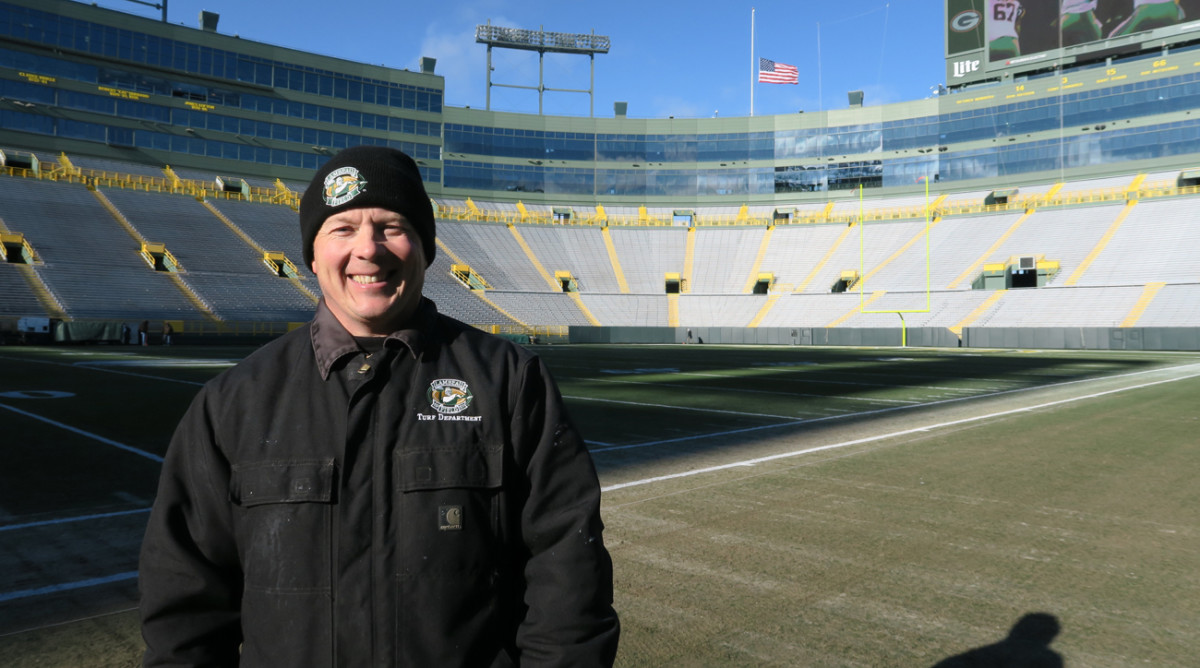Titletown’s Toughest Job: Tending the Tundra

It’s Green Bay Week at The MMQB: Our staffers are embedded for a game week, doing a deep dive into the NFL’s most tightly knit community. We’ll explore the dynamic between the players and the people of Green Bay and provide a glimpse into what makes it a bucket-list destination for football fans. Follow on Twitter for updates, Facebook for live streams, and Instagram for our “Humans of Green Bay” project.
GREEN BAY, Wis. — Wind whips around the empty bowl of Lambeau Field on a brisk Wednesday morning, a frosty reminder of this hallowed stadium’s signature challenge. The only men on the field are the four that tend the playing surface. There’s a familiar rhythm to any NFL grooming process. One worker pushes a metal cart dispersing yellow paint dashes along the end zone. Another lays out ruling wood to keep the cart straight. But this is “the Frozen Tundra,” and just like a snowflake, no two game preparations are alike.
“When you play in a climate like ours, it takes maneuvering and planning well ahead of time,” says field manager Allen Johnson, in his 20th season. “You’re always tweaking, but a lot of times it’s an educated guess of what the weather is going to be. You have to use your past experience to make decisions and hope that the weather will not surprise you.”

Johnson kneels down and palms the frosty surface. Last week the Packers endured their first snow game of the season—two to three inches of fluffy flakes fell as they defeated the Texans 21-13. This Sunday the Seahawks make a rare December visit to Wisconsin, and the forecast has fluctuated from anywhere between sub-freezing and dry to six-plus inches of wet stuff. “If we didn’t have the snow coming, and I didn’t have to tarp the field before the game, this right here would play great,” Johnson says, patting the ground. “When the temperature is below freezing and any surface moisture freezes, it almost gets sticky. That’s my ideal playing surface.”
• LIFE IN PACKERLAND:Rookie Trevor Davis | Retired great Ahman Green | Backup QB Brett Hundley | Former exec Andrew Brandt
As for that “nickname: The four men who tend the field don’t like the Frozen Tundra moniker, or rather, they believe it’s inaccurate, a vestige of one bad, but famous, day. It stems from the 1967 Ice Bowl, when the Packers hosted Dallas on New Year’s Eve for the NFL championship. The previous summer Vince Lombardi had installed a 1700-kilowatt heating system under the field, to prevent the ground from freezing in Wisconsin’s harsh conditions. But on the morning of the championship game, when the tarp was removed to minus-15-degree temperatures, Lombardi’s system failed its toughest challenge: the condensation that had built up under the tarp flash-froze, and the surface became rock hard. (The Packers have long refuted the urban legend of foul play to undermine the Cowboys that day.) Now there’s a more sophisticated system in place, a carpet of tubes a foot below the surface circulating antifreeze.
Johnson is constantly adjusting throughout the week, because once the whistle blows, he’s sidelined. “It’s hard to make game adjustments,” Johnson says. “It’s like asking someone to change the temperature of Lake Michigan. There’s no switch. It takes a long time, hours, to change. When the game starts, it’s too late.”
• BUCKET LIST—GREEN BAY: Find all of our coverage from our weeklong embed in Packers country
It’s the second week of December and the Lambeau grass is dormant; growing season is done. The emerald surface will fade to a crocodile green, then eventually meld into brown. The wear-and-tear from six Packers games (plus Wisconsin-LSU) over the past three months has thinned the high-trafficked center field. Thus, the staff treats each blade with delicacy. They never shovel. They tarp and un-tarp constantly, sometimes a dozen times a week. Sometimes they blow air over the tarp to drive snow off or melt it. For heavier accumulations, they’ll let it build up over the tarp, then plow it off with a tractor featuring rubber-bottomed blades to minimize damage. “I take a lot of pride in the way the field looks on game day,” Johnson says. “But playability is the most important.”
The wind subsides for a moment and Johnson, whose hands are a ghostly white—not from the temperature, but from a morning of mixing game paint—must take advantage of the reprieve and get back to work.
• Question or comment? Email us at talkback@themmqb.com.
